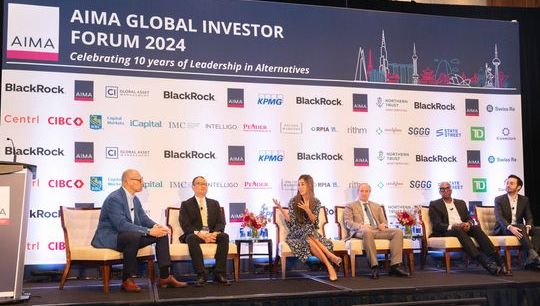AIMA/Barclays: The Extra Mile - Partnerships between Hedge Funds and Investors
By AIMA/Barclays
Published: 01 June 2014
The following is an online summary of this particular AIMA paper
I. Foreword on behalf of AIMA
I am delighted to introduce, on behalf of the AIMA[1] Investor Steering Committee, our new paper, ‘The Extra Mile: Partnerships between Hedge Funds and Investors’, written in conjunction with Barclays Capital Solutions. The paper is based on a survey of major hedge fund investors and hedge fund managers with a combined $2.2 trillion in assets.
The publication of this paper comes at an important time in the evolution of the hedge fund industry globally. Amid the ongoing process of institutionalization (a theme that we first addressed in AIMA’s Roadmap to Hedge Funds in 2008), institutional investors are actively pursuing a more direct engagement with the underlying hedge funds in which they are invested.
This paper explores the changing relationships between hedge fund managers and investors. What we have found is that investors are increasingly striking up partnerships with hedge funds. These partnerships take many forms, including the sharing of knowledge on expertise and risk management, the building of more customized products, co-investment solutions, product seeding and equity investment. As the title of the paper implies, both parties are properly investing in these relationships – they are going the extra mile – and, in doing so, are achieving significant benefits for both sides.
I would like to express our sincerest gratitude to Barclays for collaborating with the AIMA Investor Steering Committee (‘ISC’) on this project. I would also like to thank AIMA on behalf of the ISC for their continued commitment to investor engagement, which is so widespread today[2]. The ISC has been responsible for a number of publications in recent years including Beyond 60/40: the evolving role of hedge funds in institutional investor portfolios[3], the Roadmap to Hedge Funds[4] , the world’s first educational guide for institutional investors in hedge funds, and the Guide to Institutional Investors’ Views and Preferences[5], which discusses a variety of important operational and organizational issues. A final word of thanks is due to my fellow investors for devoting so much of their time to this initiative.
I hope that you enjoy this paper and find it to be as useful a reference tool as those earlier ISC publications.
Michelle McGregor-Smith
Chair, AIMA Investor Steering Committee Chief Executive
British Airways Pension Investment Management Ltd
II. Study overview
As the hedge fund (‘HF’) industry evolves and becomes increasingly institutional, many hedge funds are reorienting their business models, away from the idea of selling a fixed product offering, and instead toward the principle of becoming partners, using their expertise to deliver solutions for investors. In this piece, undertaken in conjunction with the AIMA Investor Steering Committee, we explore the development of this new trend, looking at the rationale for the development of these partnerships, what they consist of, and how managers looking to get involved in partnerships should think about them.
The main areas we address in this piece are the following:
1. Partnership rationale
a.) What have been the factors driving recent growing interest in partnerships?
b.) What are the benefits to HF managers and investors in forming partnerships?
2. Elements of partnerships
a). What are the typical elements of partnerships between HFs and investors?
b.) What defines each element, and how do they work?
c.) How prevalent are these elements relative to each other?
3. Attributes of partners
a.) What criteria do investors use to select HF managers as partners?
b.) Are HFs of a certain size / strategy more attractive?
c.) Are fee concessions essential in the context of partnerships?
4. Key considerations for HFs
a.) How should HF managers think about partnerships in the context of their strategy? Are certain types of partnerships more or less attractive?
b.) How should HFs select investors to target for building partnerships?
c.) What lessons can HFs learn from FoHFs?
Methodology
With these areas in mind, Barclays Strategic Consulting team tapped three sources to gather the required information for the study:
1. Investors
– A total of 30 investors were surveyed, including a number of members of AIMA’s Investor Steering Committee.
– These investors manage over $2tn of overall AUM and over $260bn of AUM invested in HFs.
2. Managers
– Interviewed 21 managers, including several that have been at the forefront of developing the concept of partnership with investors.
– Focused on established managers, across a range of strategies / sizes.
3. HF industry databases: over 10,000 data points analyzed from HFR, BarclayHedge, and HFN.
Figure 1 depicts the distribution of the participants interviewed, by type (for investors), strategy (for managers), geography and level of AUM.
III. Executive Summary
The following are high level takeaways from the study:
Partnership rationale
- Partnerships present significant benefits for investors and managers alike.
- HF investors have become increasingly sophisticated in their view of their HF investments, looking at HFs as a way to tailor the risk-return of their entire portfolio and, simultaneously, they have concentrated their HF portfolios to a smaller number of managers. As such, they are looking to have fewer but more meaningful relationships with HFs to obtain the following benefits:
1. Access to HF expertise/skills: Partner investors can leverage HFs’ knowledge and expertise.
2. Customization: Partner investors can work with HFs to develop customized solutions for their investment needs.
3. Increased understanding: Partner investors are likely to have greater knowledge and understanding of the managers they are partnered with.
4. Value for money: Partner investors say they can obtain more value from their HF investments, often for the same or sometimes lower fees.
- Managers have five main reasons for forming partnerships with investors:
1. ‘Stickier’ tickets: Partner investors are more likely to be loyal investors and allocations to partner HFs are generally for the longer term.
2. New product development: Partner investors can help launch new products by providing seed capital or being early investors.
3. Cross-selling opportunities: Partner investors may be more open to investing in the manager’s other products.
4. Knowledge sharing: HFs can learn from investors – e.g., a pension fund partner can be helpful in showing HFs how to interact with pensions and to cater better to their needs.
5. Investor references: Investors can act as a positive reference to fellow investors.
Elements of partnership
- Investors and managers cite six key elements they value in partnerships: highly responsive and proactive client service, knowledge sharing, customization, co-investments, product seeding and equity stakes.
- A highly responsive and proactive client service is a prerequisite to form a partnership with HFs, but partnerships have to be based on much more than that.
- Knowledge sharing comes in different flavors, each having different cost and scalability characteristics, as well as appeal to investors. No matter what form such knowledge sharing takes, the objective of HF managers is to demonstrate to investors they are the ‘go-to’ on their specific areas of expertise.
- Customization is often at the core of what partnership is for most HF investors. As investors are becoming more sophisticated, they are utilizing customized mandates to tailor their investments and risk exposures to suit their own preferences.
- Co-investments are an important way in which HFs and investors partner on opportunistic investments, many of which do not fit neatly into a commingled fund vehicle.
- Equity stakes represent a full alignment of interest and allow investors to share in the economics of HF management companies; however, they also present drawbacks and therefore only a few investors and managers choose to take this route.
Attributes of partners
- Investors care about both the right set of capabilities as well as the right attitude toward investors in the HF managers they decide to partner with.
- In terms of capabilities, larger HF firms with broad strategies are most often described as good partners, although smaller managers with narrower strategies also have a role to play and are indeed preferred by some investors.
- Investors typically value HFs which are ‘solutions-oriented’ and transparent above all else when they have to choose a partner.
- Investors are divided as to whether fee concessions are a necessary part of partnership, with half stating they are an integral part of what partnerships are and the remainder saying that partnerships are not about fees.
Key considerations for HFs
- HFs’ strategy-related characteristics have a role to play in determining the types of partnerships that make the most sense for them.
- Partnerships require time and effort, so HF managers must choose the investors they partner with carefully. Choice is a function of the size of an investor and their appetite for various elements of partnership.
- HFs can learn from the successful funds of hedge funds (FoHFs) that have reoriented themselves from being productoriented businesses toward a solutions-based model.
- Some HF managers have made the decision not to seek partnerships for a variety of reasons, suggesting that this too could be a viable strategy in the right circumstances.










